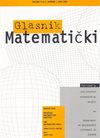\具有秩(p^4)的非阿贝尔正常子群的(CZ)群
IF 0.5
4区 数学
Q3 MATHEMATICS
引用次数: 0
摘要
一个具有它的每一个非阿贝尔子群都有一个微不足道的中心子(即只有它的中心)的性质的(p)-群(G)被称为(CZ)-群。 在 Berkovich 的专著(见 [1])中,对 \(CZ\)- 群结构的描述被作为一个研究课题。在此,我们在 [5] 中证明的结果的基础上进一步推进这一课题。在这篇论文中,我们描述了拥有一个阶为 \(p^4\) 的非阿贝尔正常子群的 \(CZ\)-groups \(G)的结构,这个子群包含在 Frattini 子群 \(\Phi(G).\) 中。我们设法证明了这样一个阶为 \(p^4\) 的群是唯一的,并且整个群 \(G\) 的阶小于或等于 \(p^7\),\(p\) 是一个素数。此外,所有这样的群\(G\) 都被证明是小于最大的类。本文章由计算机程序翻译,如有差异,请以英文原文为准。
\(CZ\)-groups with nonabelian normal subgroup of order \(p^4\)
A \(p\)-group \(G\) with the property that its every nonabelian subgroup has a trivial centralizer (namely only its center) is called a \(CZ\)-group. In Berkovich's monograph (see [1]) the description of the structure of a \(CZ\)-group was posted as a research problem. Here we provide further progress on this topic based on results proved in [5]. In this paper we have described the structure of \(CZ\)-groups \(G\) that possess a nonabelian normal subgroup of order \(p^4\) which is contained in the Frattini subgroup \(\Phi(G).\) We manage to prove that such a group of order \(p^4\) is unique and that the order of the entire group \(G\) is less than or equal to \(p^7\), \(p\) being a prime. Additionally, all such groups \(G\) are shown to be of a class less than maximal.
求助全文
通过发布文献求助,成功后即可免费获取论文全文。
去求助
来源期刊

Glasnik Matematicki
MATHEMATICS, APPLIED-MATHEMATICS
CiteScore
0.80
自引率
0.00%
发文量
11
审稿时长
>12 weeks
期刊介绍:
Glasnik Matematicki publishes original research papers from all fields of pure and applied mathematics. The journal is published semiannually, in June and in December.
 求助内容:
求助内容: 应助结果提醒方式:
应助结果提醒方式:


